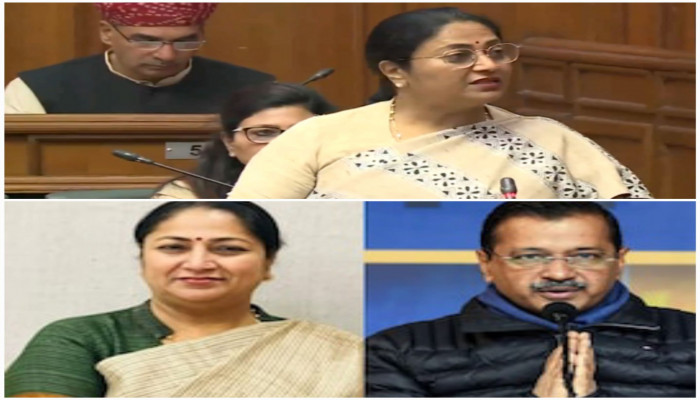CAG report reveals ₹2,002 crore loss due to AAP’s Delhi liquor policy
- In Reports
- 06:26 PM, Feb 25, 2025
- Myind Staff
The CAG report on the Delhi Excise Policy, presented during the Delhi Assembly session on Tuesday, highlighted several decisions that led to financial losses. These included not opening retail shops in non-conforming wards, which resulted in a loss of ₹941.53 crore, and the failure to re-tender surrendered licenses, causing a ₹1,890 crore loss. Additionally, granting a COVID-19 fee waiver to zonal licensees despite the Excise Department's objections led to a ₹144 crore loss, while not collecting adequate security deposits from zonal licensees resulted in a ₹27 crore shortfall.
The report also pointed out that the failure to enforce Rule 35 of the Delhi Excise Rules, 2010, allowed licenses to be granted to wholesalers with interests in manufacturing and those with ties to retailers. This led to a conflict of interest and disrupted the liquor supply chain by enabling common ownership across manufacturing, wholesale, and retail sectors.
The move was justified as necessary to fund a quality-checking system, which included setting up government-approved labs at warehouses. However, no such labs were ever established. As a result, wholesale license holders saw their profit margins rise while government revenue declined.
The AAP government issued retail liquor licenses without verifying applicants' solvency, financial records, or criminal backgrounds. Operating a liquor zone required an initial investment of over ₹100 crore, yet no financial eligibility criteria were set. This led to licenses being granted to financially weak entities, with several bidders showing little to no income over the past three years. These circumstances suggest the possibility of proxy ownership, raising concerns about political favouritism and undisclosed agreements.
Additionally, while formulating the 2021-22 Excise Policy, the AAP government ignored the recommendations of its own Expert Committee without providing any formal explanation for the decision.
The policy allowed a single applicant to manage up to 54 liquor outlets, a significant increase from the previous limit of two. This change encouraged monopolies and cartelisation. Government corporations operated 377 liquor stores earlier, while private individuals ran 262. Under the new policy, the number of retail zones increased to 32, with 849 vendors in total. However, only 22 private entities were granted licenses, reducing transparency and fairness.
In addition, AAP’s policy required manufacturers to work with a single wholesaler, allowing a few wholesalers to dominate the market. Of the 367 registered IMFL brands, just 25 accounted for nearly 70% of total liquor sales in Delhi. Three wholesalers, Indospirit, Mahadev Liquors, and Brindco, controlled over 71% of the supply. These firms also had exclusive rights to distribute 192 brands, effectively determining which brands succeeded or failed. As a result, consumers had fewer choices, liquor prices could be artificially raised, and the government lost potential revenue due to reduced competition.
Pivotal exemptions and relaxations that significantly impacted revenue were granted without seeking Cabinet approval or consulting the Lieutenant Governor, violating legal procedures.
The AAP-led Excise Department approved liquor stores in nonconforming areas, such as residential and mixed land-use zones, without securing mandatory clearance from the MCD or DDA.
Inspection teams falsely reported that four liquor outlets in Zone 23 were in commercial areas, despite applicants admitting they were in residential or mixed-use zones. Despite these violations, licenses were still issued. Eventually, the MCD sealed all four illegal liquor stores in early 2022, proving that due process had been bypassed.
The Excise Department allowed L1 license holders to determine their own Ex-Distillery Price (EDP) for premium liquor, resulting in price manipulation.
Public safety was compromised as licenses were issued even when quality test reports were missing or did not comply with Bureau of Indian Standards (BIS) norms. Some reports submitted by licensees came from labs that lacked accreditation from the National Accreditation Board for Testing and Calibration Laboratories (NABL), violating FSSAI guidelines.
In 51% of foreign liquor testing cases, reports were either outdated, missing, or undated, highlighting serious lapses in quality control. Additionally, tests for harmful substances such as heavy metals and methyl alcohol were either absent or overlooked, raising major safety concerns.
The EIB (Excise Intelligence Bureau) did not take proactive measures to curb smuggling, particularly of country liquor, which accounted for 65% of the confiscated stock. Their approach was limited to recording seizures rather than actively preventing the illegal trade.
An analysis of FIRs highlighted recurring smuggling patterns in specific areas, yet the government failed to intervene. This inaction suggests either negligence or potential collusion.
The Excise Department maintained incomplete and outdated records, making monitoring revenue losses or identifying smuggling trends challenging. Restrictions on supply, limited brand choices, and constraints on bottle sizes led to a rise in the illegal country liquor trade.
The AAP government did not take action against liquor license holders who violated Excise laws. Raids were carried out in an unorganised manner, resulting in poor enforcement.
Cases against violators were weakened due to a lack of proper evidence collection and verification. Inspection reports were inaccurate, and Show Cause Notices were poorly written, reducing the effectiveness of legal actions.
The Excise Adhesive Label project, meant to ensure product authenticity and prevent tampering, was never implemented, exposing the supply chain to fraud. Instead of leveraging modern data analytics and AI for fraud detection, AAP’s excise policy relied on outdated and inefficient tracking methods.







Comments